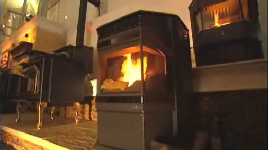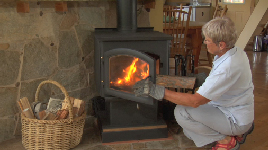Wood Stoves and Fireplaces
Clean Home Heating
Many people don’t think of the smoke from their wood stove or fireplace as air pollution. Some people even like the smell of wood smoke. But wood smoke is one of the main sources of air pollution in Washington.
Wood smoke contains fine particles, PM 2.5, which are associated with serious health effects, as the tiny size of these pollutants allows them to be easily inhaled, bypassing the immune system and proceeding deep into your lungs, where they can cause respiratory and cardiovascular problems, including premature death.
In winter, more than half of Washington’s fine particle air pollution comes from the homes being heated using wood. Wood stoves, fireplaces and other wood-burning devices put out hundreds of times more air pollution than other sources of heat such as natural gas, propane, oil or electricity.
Video on How to Select a New Stove for Home Heat
Video on How to Operate Your Wood Stove More Efficiently
The fire: Give it air!
The right amount of air gives you a hotter fire and more complete combustion. That translates to more heat from your wood and less smoke and pollution. Here are some cleaner burning tips:
- Build small, hot fires. Don’t add too much fuel at one time.
- Step outside and check the chimney or flue. If you can see smoke, your fire may need more air.
- Read and follow the stove manufacturer’s instructions.
- Don’t “bank” the stove full of wood and damper down the air supply. This wastes wood, produces much air pollution, promotes accumulation of creosote (which requires more frequent cleaning and can lead to chimney fires) and yields very little heat. Half-full is adequate; it provides enough air space for efficient combustion.
- Don’t damper down too far. Allow enough air to reach the wood. This varies among models and kinds of stoves.
- Make sure your stove is the right size for your home. Too large a stove will overheat your living space. You’ll want to damper down. This causes added pollution and wastes wood.
- Don’t burn in moderate temperatures. You’ll want to damper down, which causes more pollution and wastes wood.
- Don’t burn when air currents carry your smoke to your neighbor’s yard or house.
- Only burn dry, seasoned firewood, never garbage. Burning garbage is illegal in the state of Washington and creates a greater health hazard.
The fuel: keep it dry!
Wood can seem dry and still contain plenty of water, up to 50 percent. The moisture in wood makes the fire give off more smoke. On the other hand, dry wood can provide up to 44 percent more heat. It is against state law to burn wood with more than 20 percent moisture content in fireplaces or wood stoves.
Two things work very well at making sure your wood is dry enough: time and cover. Whether you buy wood or harvest your own, follow these tips to get it fire-ready:
- Split it. The wood will dry best and burn most efficiently if the pieces are three and one-half to six inches in diameter.
- Cover it. Protect the wood from rain and weather. Stack it loosely-in layers of alternating directions- to allow plenty of air circulation. Store it at least six inches off the ground.
- Give it a year. Wood that has been split, dried and stored under cover for at least one year usually meets the 20 percent moisture content requirement.
State law does not regulate the dryness of any wood sold. If the seller states that the wood is dry or seasoned, consider it a claim; make sure for yourself. You—and not the seller—are responsible for the dryness of the wood you put on your fire.
Frequently Asked Questions
Can I burn in my woodstove, fireplace, or barbecue on a “no burn day”?
 Yes. Woodstove, fireplace, and barbecue use is unrestricted at all times. The burn day decision does not apply to these devices. The only time when use is restricted is during a statewide air pollution episode, which occurs rarely.
Yes. Woodstove, fireplace, and barbecue use is unrestricted at all times. The burn day decision does not apply to these devices. The only time when use is restricted is during a statewide air pollution episode, which occurs rarely.
Can I burn paper or garbage in my woodstove, fireplace, or barbecue?
Washington State law prohibits the burning of paper, except that which is necessary to start the fire. Burning large amounts of paper is potentially very dangerous as often large burning embers exit the chimney and can cause fires outside the home. The burning of garbage is strictly prohibited by State law.
How do I know if I am burning correctly in my woodstove or fireplace?
Your woodstove, fireplace, or barbecue must be used in accordance with the manufacturer’s instructions. Also, the amount of smoke produces by these devices must be minimized. The smoke coming out of your chimney should be almost colorless and thin. Thick, white or black smoke indicates that your fire is not receiving enough air. Woodstoves, fireplaces, and barbecues should be used in such a way as to minimize the impact on neighbors. Here are some additional tips:
- Burn only dry fuel. Moist wood gives off more smoke and may produce up to 44% less heat.
- Ideally, burn wood that has been split and dried for one year.
- Never burn painted, stained or treated wood, colored newsprint, plastic, cardboard, garbage, diapers or magazines.
- Twenty minutes after starting your fire, check your chimney for smoke. If you see any smoke, it probably exceeds the legal limit. Increase air to the fire for cleaner burning.
- Burn small hot fires and allow plenty of air to reach the fire. Avoid excessive dampening to extend the duration of the burn, see The Myth of Air-Starved Burning below.
- Never allow the fire to smolder. Smoldering fires pollute, are inefficient and are a fire hazard.
One myth, which is perhaps the most damaging to air quality and potentially damaging to health and safety, is that there are benefits to starving a wood stove for adequate combustion of air. A fire starved for air is excessively smoky because of incomplete combustion and therefore produces more unburned particulates and gaseous air pollutants than a hot fire with adequate air. Poor combustion also promotes the buildup of creosote in chimneys posing a fire hazard. Carbon monoxide from incomplete combustion can also buildup inside houses posing a direct threat of death by asphyxiation.
This myth had its origin in the 1970’s energy crisis when the popularity of wood stoves increased. Many poorly designed stoves have been marketed that are not air-tight and otherwise have poor combustion air controls. Manufacturers may have recommended, or owners may have discovered, the technique of severely restricting air flow to compensate for poor design. In addition, marginal economics and high labor requirements of wood burning have made conservation of wood a priority, which makes reducing wood consumption yet another excuse for starving wood stove fires for air.
Burning of uncured wood with moisture contents over 20% compounds the problems of poor combustion from air-starved fires by promoting even greater production of air pollutants and creosote. Burning high moisture wood decreases the usable energy from the wood because heat from burning is diverted into evaporating the water rather than heating the air as desired.
What are some of health effects from breathing smoke from woodstove, fireplaces or barbecues?*
Breathing air containing wood smoke can:
- reduce lung function, especially in children;
- increase severity of existing lung disease such as asthma, emphysema, pneumonia and bronchitis;
- aggravate heart disease;
- increase susceptibility to lower respiratory diseases;
- irritate eyes, lungs, throat and sinuses;
- trigger headaches and allergies.
Those at greatest health risk from wood smoke include:
- fetuses, infants and children;
- people with lung, heart, circulatory diseases or allergies;
- the elderly;
- cigarette smokers and ex-smokers.
Contents of wood smoke:
There are many components to wood smoke that can cause risk to your health. These compounds include:
- carbon monoxide, fatal in high concentrations;
- formaldehyde, a possible cause of human cancer;
- organic gases which may interfere with lung function;
- nitrogen oxides, linked to hardening of the arteries;
- tiny smoke particles that lodge in the lungs causing structural damage. These tiny particles, or PM10, are less than 10 microns wide, or about 1/7 the diameter of a human hair.
What if my neighbor’s woodstove or fireplace is producing a strong, foul odor?
The primary cause of foul odors from woodstoves and fireplaces is the burning of green wood. Because green wood contains so much water, it does not burn efficiently and essentially just smolders. Smoldering fires are not hot enough to destroy the bulk of the odors. The solution to such a problem is to burn well-seasoned, dry wood in a hot fire, with lots of air. If you are bothered by a neighbor’s smoke, you should contact the BCAA office or file a complaint
What are the restrictions on buying or selling a used woodstove or fireplace in Benton County?
Since July 1, 1992, only EPA certified wood stoves and fireplace inserts may be legally sold or installed in Washington. There should be a metal tag permanently affixed to the device that will indicate EPA certification. According to Washington State law and BCAA Regulation 1, it is illegal to advertise to sell, offer to sell, sell, bargain, exchange, or give away an uninstalled used uncertified fireplace or woodstove. If you have any questions, please contact the BCAA.
A list of EPA certified woodstoves can be found at the Washington State Department of Ecology Air Program website




